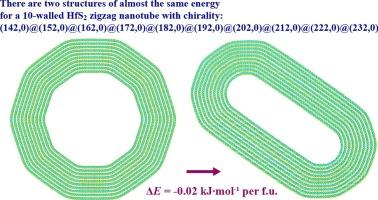Density functional and force field modeling of achiral multi-walled MX2 (M = W, Hf; X = S, Se) nanotubes
IF 2.4
3区 化学
Q4 CHEMISTRY, PHYSICAL
引用次数: 0
Abstract
The investigation of transition metal dichalcogenide nanotubes is characterized by significant variability. The majority of experimental studies on these materials focus on the structural and optical properties of MoS2 and WS2 multi-walled nanotubes (MWNTs). In contrast, research on WSe2 nanotubes has received comparatively little attention. Only a limited number of studies have synthesized and explored the MWNTs based on HfS2 and HfSe2. Theoretical researches mainly include density functional theory (DFT) calculations for single-, double-, and triple-walled nanotubes with relatively small diameters. We propose new atomistic potentials designed to model the MWNTs based on W and Hf dichalcogenides, whose diameters approach the experimentally observed ones and are beyond the capabilities of ab initio methods. The developed force fields have been applied to the study of the structure and stability of achiral nanotubes, which are composed of 1–10 single-wall components. The properties of WX2-based nanotubes are compared with those of analogous HfX2-based nanotubes (X = S, Se). In particular, it has been shown that HfX2 multi-walled nanotubes are much more faceted than similar WX2 multi-walled nanotubes. The stability of multi-walled nanotubes with respect to single-wall components and nanolayers was investigated. For the first time, it has been found that the binding energy of achiral MWNTs is a linear function of the inverse wall number. The slope of the resulting line is related to the interwall adhesion energy.

非手性多壁MX2 (M = W, Hf; X = S, Se)纳米管的密度泛函和力场建模
过渡金属二硫化物纳米管的研究具有显著的可变性。这些材料的大部分实验研究集中在二硫化钼和WS2多壁纳米管的结构和光学性质上。相比之下,WSe2纳米管的研究受到的关注相对较少。目前,基于HfS2和HfSe2的MWNTs的合成和探索研究数量有限。理论研究主要包括小直径单壁、双壁和三壁纳米管的密度泛函理论(DFT)计算。我们提出了新的原子势来模拟基于W和Hf二硫化物的MWNTs,其直径接近实验观察到的直径,超出了从头计算方法的能力。所建立的力场已被用于研究由1-10个单壁组分组成的非手性纳米管的结构和稳定性。比较了wx2基纳米管与类似的hfx2基纳米管的性能(X = S, Se)。特别是,HfX2多壁纳米管比WX2多壁纳米管具有更多的多面性。研究了多壁纳米管相对于单壁组分和纳米层的稳定性。首次发现了非手性MWNTs的结合能是逆壁数的线性函数。所得直线的斜率与壁间粘附能有关。
本文章由计算机程序翻译,如有差异,请以英文原文为准。
求助全文
约1分钟内获得全文
求助全文
来源期刊

Chemical Physics
化学-物理:原子、分子和化学物理
CiteScore
4.60
自引率
4.30%
发文量
278
审稿时长
39 days
期刊介绍:
Chemical Physics publishes experimental and theoretical papers on all aspects of chemical physics. In this journal, experiments are related to theory, and in turn theoretical papers are related to present or future experiments. Subjects covered include: spectroscopy and molecular structure, interacting systems, relaxation phenomena, biological systems, materials, fundamental problems in molecular reactivity, molecular quantum theory and statistical mechanics. Computational chemistry studies of routine character are not appropriate for this journal.
 求助内容:
求助内容: 应助结果提醒方式:
应助结果提醒方式:


